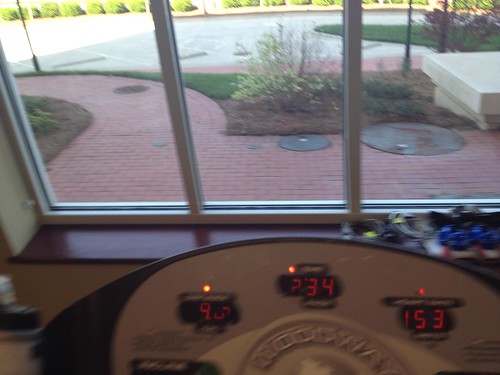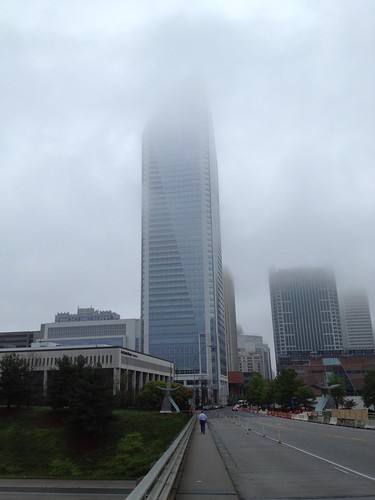As it turned out, I would have to do a little more than just run. I was going to be participating in a scientific study of running performance. The study was evaluating the effect of a dietary supplement called NutraSorb. Participants in the study would have to take a test evaluating their VO2 max, then take the supplement, and finally run on a treadmill for two and a half hours, three days in a row.
The link above describes my VO2 max test, which was a tough challenge of its own. But given my well-professed aversion to treadmills, I knew the treadmill portion of the study would be the most difficult part for me.
Before I did that, however, I would have to take the supplement, twice a day, for two weeks. In fact I didn't know if I was even taking the supplement; I might have been in the group of participants assigned the placebo. Whatever group I was in, the supplement itself was no fun at all, it was a black powder with roughly the consistency of sandpaper. I tried mixing it with yogurt, but the result was a horrific black sludge. I finally realized the best course of action was just to mix it with as little water as possible, and suck it down as fast as possible. The last gulp was always accompanied by the gritty sludge on the bottom of the cup, which I had to chew in order to swallow.
Finally on Monday I arrived for my first treadmill test day. I was to run for two hours and fifteen minutes at 75% of VO2 max, meaning the speed at which I consumed 75% of the maximum amount of oxygen I can process. The researchers estimated this at 6.5 miles per hour, or roughly a 9:13 pace. This is normally an easy pace for me, but on the treadmill, all bets are off. Sure enough, after an hour or so on the treadmill, things started getting rough. I had an iPod with an interesting audiobook loaded, but I found I couldn't stand listening for more than 45 minutes at a time. I was sweating profusely, and my singlet was absolutely drenched. Although the study room was well air-conditioned, it was still warm for me for a run, especially with only a fan to cool me. If I had been outside, just the breeze from my own running pace would kept me much cooler.
At one hour the researchers put on the oxygen mask and tested my oxygen consumption to make sure I was around 75% of VO2 max. They didn't change my speed so I assume they had estimated correctly at the outset. I also had to consume another dose of supplement. I kept running. I alternated listening to music, my audiobook, and running in silence. The study room had a TV, but because there were five of us running at once, there was no place to put it where everyone could see, so they left the TV off. Instead, I looked out the window at the lab's driveway, and across the driveway, at a barren field:
 |
| My view for 7.5 hours this week |
About 90 minutes in I started to feel my singlet chafing, so I decided to remove it: modesty be damned; at this point I just wanted to finish. Finally I had been running for 2 hours and 15 minutes and I'd get to enter the final phase: a 15-minute time-trial where the goal was to run as far as possible. I increased the pace to 6.8 miles per hour, what should still be an easy 8:49 pace. I was running faster than this at the end of the Richmond Marathon, but somehow today this seemed very difficult. I bumped the pace to 7 mph, 8:34 miles. C'mon, Dave, you can do this for 15 lousy minutes. After 5 minutes, I had to slow down again, but I rallied for the final 5 minutes and finished at around 8 mph. I probably could have done a little more, but I knew I'd have to come back two more days for more of the same. At the end of the session and my weight was compared to the starting weight. Despite drinking two liters of water during the run, I had lost 7 pounds in sweat!
Day two was much harder than day one. I was wearing a heart rate monitor, and on day one it had been in the 140s most of the time. On day 2 it started over 150, and kept increasing. After an hour I asked the researchers to slow the treadmill down, so they reduced the pace to 6.2 mph, 9:40 miles, which still felt intolerably difficult. 30 minutes later I asked if I could take a 2-minute walk break. They said I could go to the bathroom. I didn't need to go, but I went anyways. When I returned, they reduced my pace again, to 6 mph -- 10-minute miles. I should be able to do this kind of a pace in my sleep. I barely finished, and my final time trial was done at 6.5 mph for nearly the whole time.
Amazingly, I felt better on day 3, and was able to do the entire run at 6.5 mph, just like on day 1. By the time I got to the final time trial, however, I was exhausted, and unable to increase the speed until there was only about 7 minutes left. By the final minute I recovered enough to boost my speed to 9 mph, a respectable 6:40 pace. Over the three days I ran a total of 48.74 miles, certainly the most mileage I've ever run in such a short time.
I had been concerned that I might feel absolutely horrible after such an ordeal, but I found that I recovered quite well. This was hard, but clearly nowhere nearly as hard as running a marathon. Even my IT band, which usually flares up after a difficult workout, seems to be doing just fine. I'm not sure if that's because of the supplement (or placebo effect), or because despite its monotony, the treadmill is actually lower-impact than running that distance on roads. This morning I completed the final requirement of the study, a blood draw.
The only remaining decision was what I'd buy with my honorarium for participating in the study. In fact the decision had been made a week ago; I'd be buying a new GPS system -- a Garmin 910xt. It's probably overkill for my training regimen. I don't do much cross-training, and I never swim. I don't need its 20-hour battery life. But its crystal-clear screen, its barometric altimeter, and the ability to sync with my computer wirelessly won me over. Plus, given the proceeds of this experiment, it's basically free. Hard to argue with that!
It will be several months at the soonest before these study results are published. I have asked to be sent a copy of the final paper, so when it's ready, I'll be sure to share it with you either here or over on Science-Based Running.
I had been concerned that I might feel absolutely horrible after such an ordeal, but I found that I recovered quite well. This was hard, but clearly nowhere nearly as hard as running a marathon. Even my IT band, which usually flares up after a difficult workout, seems to be doing just fine. I'm not sure if that's because of the supplement (or placebo effect), or because despite its monotony, the treadmill is actually lower-impact than running that distance on roads. This morning I completed the final requirement of the study, a blood draw.
The only remaining decision was what I'd buy with my honorarium for participating in the study. In fact the decision had been made a week ago; I'd be buying a new GPS system -- a Garmin 910xt. It's probably overkill for my training regimen. I don't do much cross-training, and I never swim. I don't need its 20-hour battery life. But its crystal-clear screen, its barometric altimeter, and the ability to sync with my computer wirelessly won me over. Plus, given the proceeds of this experiment, it's basically free. Hard to argue with that!
It will be several months at the soonest before these study results are published. I have asked to be sent a copy of the final paper, so when it's ready, I'll be sure to share it with you either here or over on Science-Based Running.








